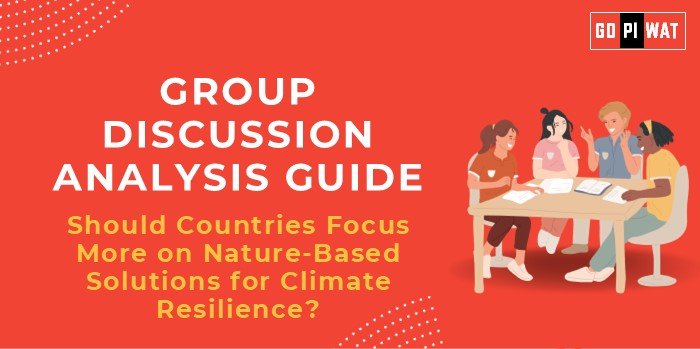📋 Group Discussion (GD) Analysis Guide
🌍 Should Countries Focus More on Nature-Based Solutions for Climate Resilience?
🌟 Introduction to the Topic
Opening Context: Nature-based solutions (NbS) offer innovative ways to enhance climate resilience by leveraging natural processes. With escalating climate risks, NbS has emerged as a cost-effective and sustainable alternative to engineered solutions, gaining prominence in global environmental strategies.
Topic Background: Nature-based solutions encompass practices like afforestation, wetland restoration, and urban green spaces. These strategies aim to mitigate climate impacts while providing co-benefits such as biodiversity conservation and improved human health. The approach is endorsed in key international frameworks, including the Paris Agreement and UN’s Sustainable Development Goals (SDGs).
📊 Quick Facts and Key Statistics
- 💰 Cost-effectiveness: NbS can reduce disaster recovery costs by up to 60% compared to conventional infrastructure.
- 🌳 Carbon Sequestration: Reforestation initiatives absorb approximately 2.6 billion metric tons of CO2 annually.
- 🌍 Global Coverage: 137 countries have integrated NbS into their climate action plans.
- 💵 Economic Benefits: Restoration of mangroves provides $82 billion annually in flood protection benefits.
👥 Stakeholders and Their Roles
- Governments: Policy frameworks, funding, and implementation of large-scale NbS projects.
- Private Sector: Investment in green infrastructure and sustainable business models.
- Communities: Active participation in local conservation efforts.
- International Organizations: Research, capacity building, and funding support, e.g., UNEP, WWF.
🏆 Achievements and Challenges
🌟 Achievements:
- 🌴 Mangrove Restoration: Coastal protection in Bangladesh has reduced cyclone impacts by 25%.
- 🌳 Urban Green Spaces: Singapore’s green infrastructure reduced city temperatures by up to 4°C.
- 🌲 Afforestation: India’s Compensatory Afforestation Program sequestered 12 million tons of CO2 in 2022.
⚠️ Challenges:
- 💵 Funding Gaps: Nature-based projects receive only 3% of global climate funding.
- ⚙️ Implementation Barriers: Land-use conflicts and limited technical expertise.
- 📊 Monitoring Difficulties: Long-term impacts of NbS are hard to quantify.
Global Comparisons:
- ✅ Success Story: Norway’s afforestation programs effectively integrate local communities, achieving 40% of their carbon neutrality target.
- ❌ Challenge Example: Brazil’s deforestation rate undermines global climate resilience efforts.
Case Studies:
- 🌍 Kenya’s Green Belt Movement: Empowered women-led afforestation to restore degraded land.
📑 Structured Arguments for Discussion
- Supporting Stance:
“Nature-based solutions are scalable, cost-effective, and address climate change while enhancing biodiversity.”
- Opposing Stance:
“NbS lack reliability during extreme events and can compete with developmental land use.”
- Balanced Perspective:
“Combining NbS with traditional infrastructure offers a resilient and comprehensive approach to climate change.”
✨ Effective Discussion Approaches
- Opening Approaches:
- 📊 Highlight economic benefits: “NbS can reduce disaster recovery costs by 60% and provide $82 billion in flood protection annually.”
- 🌍 Global Success Stories: “Norway’s afforestation program shows how NbS integrates community engagement with national goals.”
- ⚖️ Comparison: “Contrasting NbS with engineered solutions highlights their cost-effectiveness and environmental co-benefits.”
- Counter-Argument Handling:
- Acknowledge challenges and propose integrated models.
- Use evidence from case studies to refute misconceptions.
🔍 Strategic Analysis of Strengths and Weaknesses
- 💡 Strengths: Cost-effective, scalable, co-benefits like biodiversity and health.
- ⚠️ Weaknesses: Long implementation times, reliance on ecosystems.
- 📈 Opportunities: Climate funding, global partnerships, innovative designs.
- 🌋 Threats: Climate variability, policy inconsistencies, industrial opposition.
🏫 Connecting with B-School Applications
- Real-World Applications:
- 🌿 Designing NbS-driven projects in supply chains or operations management.
- Sample Interview Questions:
- “How can NbS balance urban development and climate goals?”
- “Discuss a successful NbS initiative and its economic implications.”
- Insights for Students:
- 📘 Explore NbS in finance (green bonds), entrepreneurship (eco-friendly startups), and consulting (climate resilience strategies).
- 🌍 Focus on interdisciplinary approaches to NbS implementation in global contexts.


